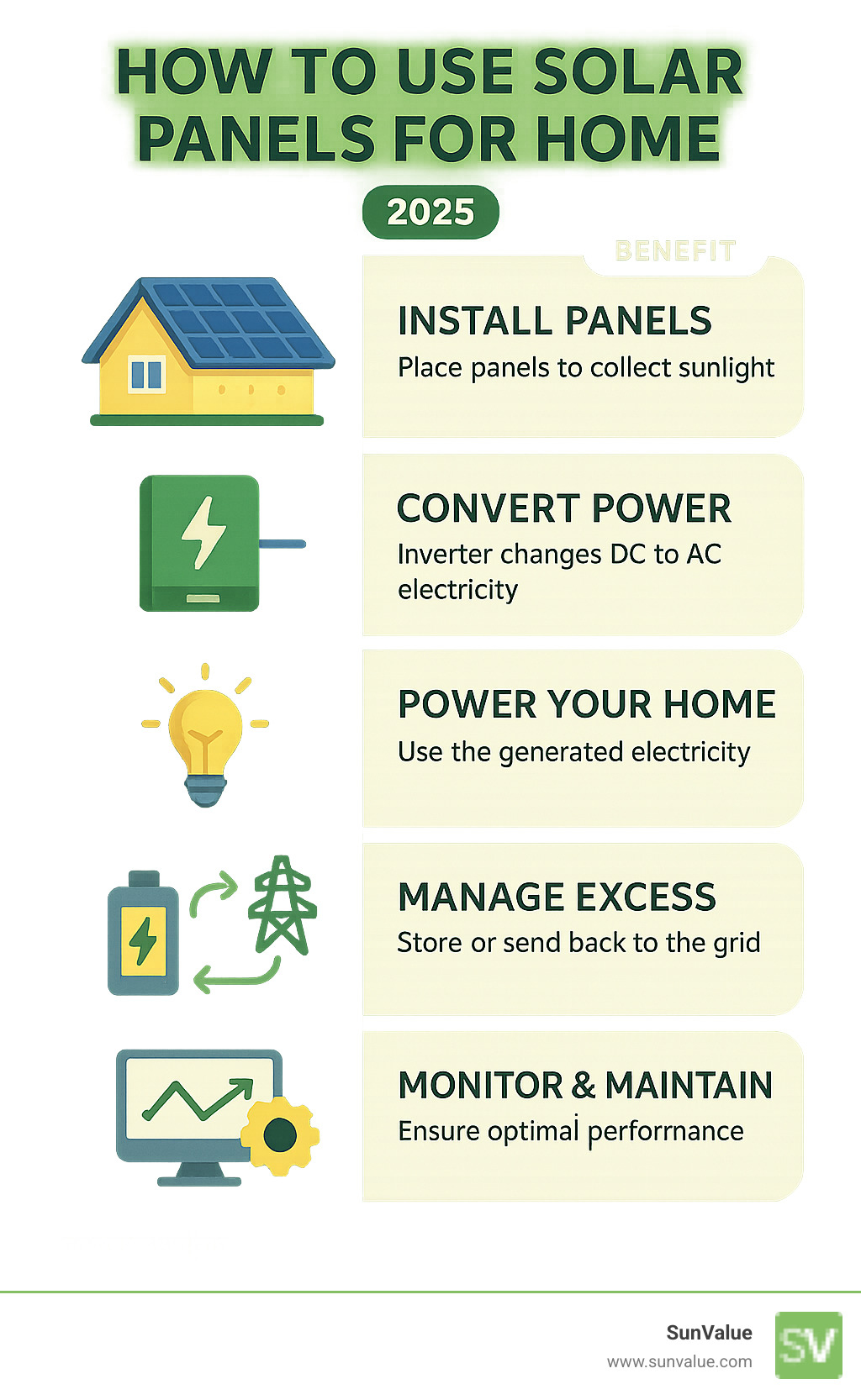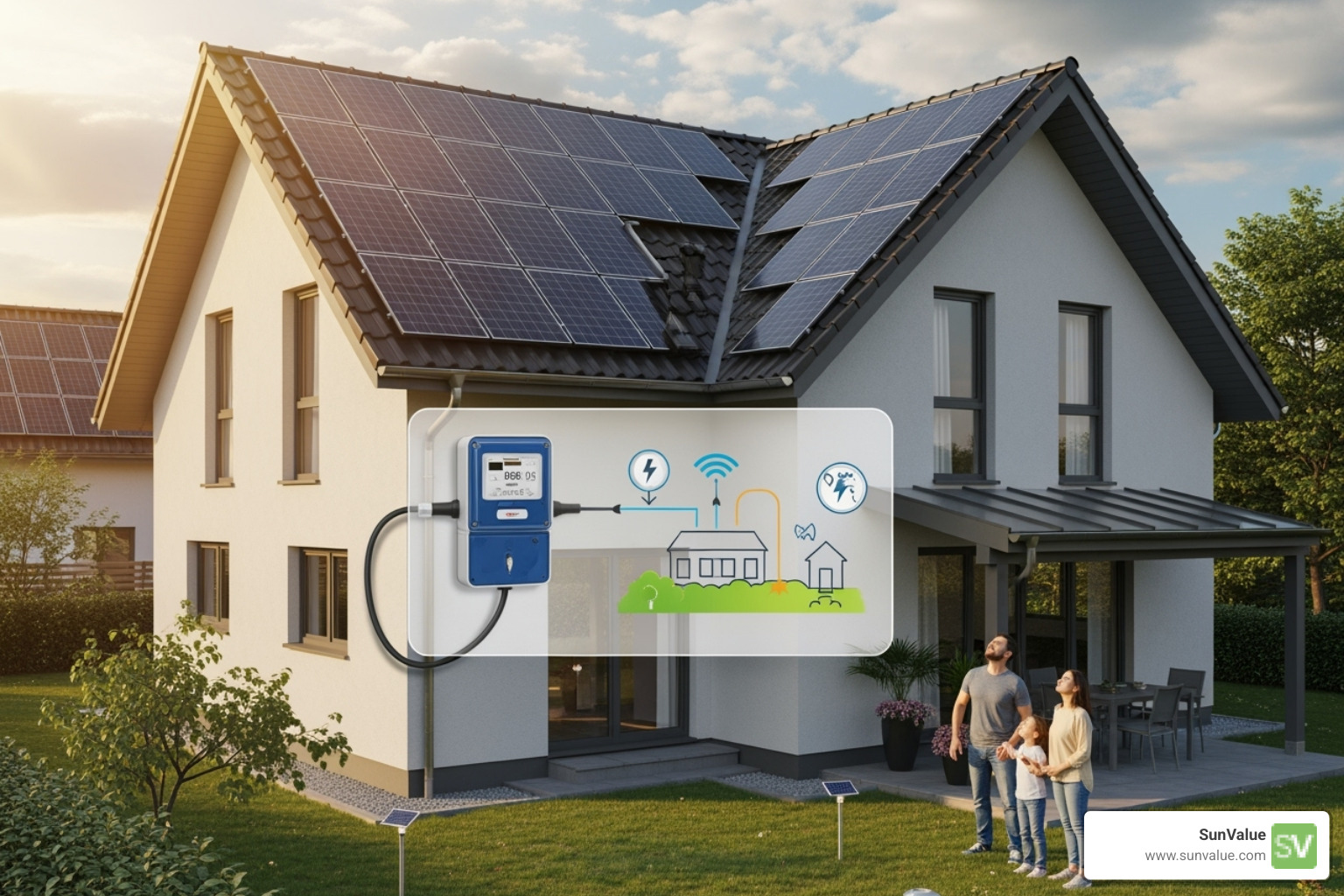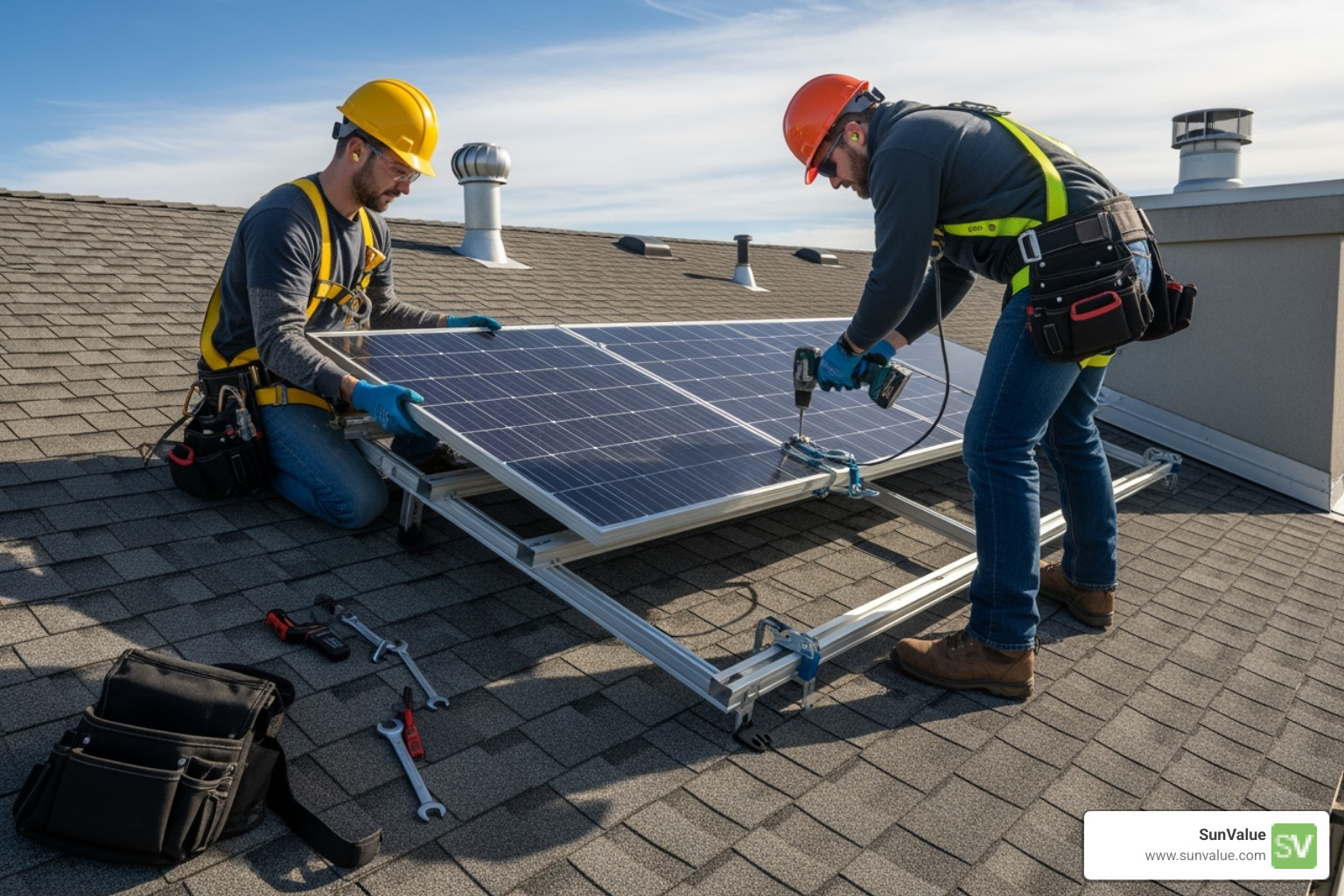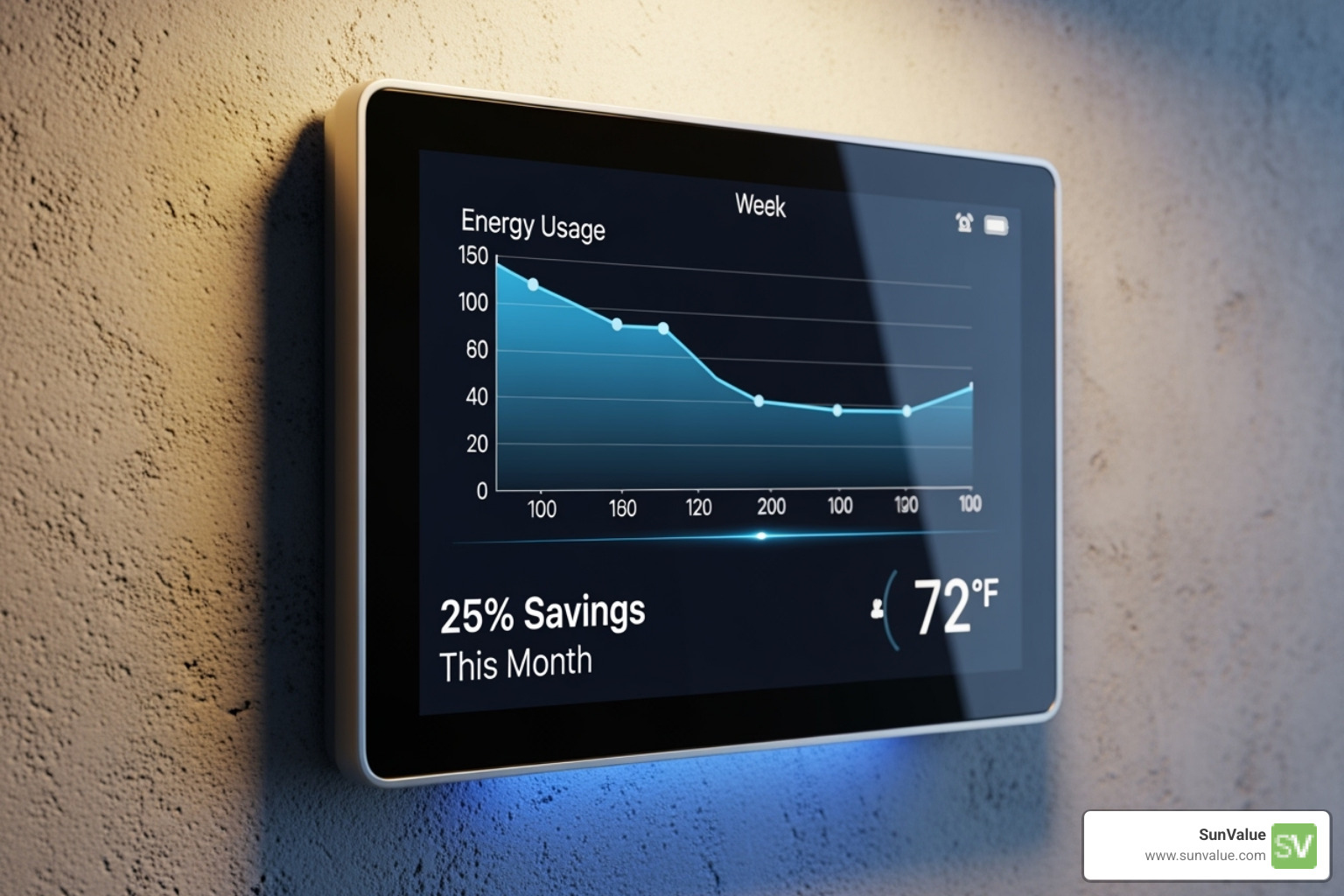Key takeaways
On this page
magine cutting your electricity bills, shrinking your carbon footprint, and tapping into the sun's clean, abundant energy. Learning how to use solar panels for home makes this a reality, offering financial and environmental benefits.
Power Up Your Home: A Guide to Solar Panels
Here's a quick overview of how solar panels work for your home:
- Install Panels: Place solar panels on your property to collect sunlight.
- Convert Power: An inverter changes solar energy into usable electricity.
- Power Your Home: Use the electricity for lights, appliances, and devices.
- Manage Excess: Send extra electricity to the grid for credits or store it in batteries.
- Monitor & Maintain: Track system performance and clean panels for best results.
Millions of homeowners save an average of $1,000 to $1,500 annually on utility bills, which can total $20,000 to $96,000 over the panels' lifespan. Additionally, homes with solar panels sell for about 6.9% more on average.
This guide covers everything from how solar panels work to costs, incentives, and tips for maximizing your system's efficiency.
I'm Nina Golban from SunValue. My work focuses on helping homeowners like you use solar panels to maximize savings and accept clean energy. I've seen how understanding your system helps open up its full potential.

The Fundamentals: How Solar Panels Power Your Home
This section explains the science behind solar power and the components of a residential solar system, giving you the foundational knowledge to understand how to use solar panels for home.
How Solar Energy Becomes Household Electricity
The process of turning sunshine into electricity relies on the photovoltaic effect. Solar panels contain silicon cells that create an electric current when exposed to light. Sunlight excites electrons in the silicon, generating Direct Current (DC) electricity. Since homes and the grid use Alternating Current (AC), a solar inverter is essential. This device converts DC power into usable AC electricity for your home. Any excess electricity can be sent to the grid for credits or stored in a battery.
Essential Components of Your Home Solar System
A complete home solar system is a team effort where every part plays a crucial role.

First are the solar panels (PV modules), which collect sunlight. The two main types for homes are:
- Monocrystalline panels: Known for their sleek black look and higher efficiency, they produce more power in smaller spaces but are more expensive.
- Polycrystalline panels: These have a blue, checkered look and offer a great balance of performance and cost, though they are slightly less efficient.
Next is the critical solar inverter, which converts the DC electricity from your panels into usable AC power for your home. The racking and mounting equipment is the sturdy framework that securely holds your panels on the roof at the optimal angle for sun exposure.
If you're connected to the grid, a net meter tracks the electricity you pull from the utility and the excess power you send back, which is how you earn credits on your bill.
Finally, an optional solar battery storage system lets you store surplus energy produced during the day. This stored power can be used at night, during cloudy weather, or during a grid outage, providing backup power and greater energy independence.
Grid-Tied vs. Off-Grid: Understanding Your Connection
When considering how to use solar panels for home, you'll need to decide how your system connects to the wider energy grid.
A grid-tied system, the most common setup, keeps your home connected to the local utility. When your panels produce excess electricity, it's sent to the grid for credits on your bill through net metering. For safety, these systems shut down during a power outage, so you won't have power unless you have a battery backup.
An off-grid system offers complete energy independence from utility bills. These systems are not connected to the grid and rely on large battery banks to store enough energy for when the sun isn't shining. This option has higher upfront costs and requires careful energy management.
A hybrid system offers the best of both worlds, combining a grid-tied setup with battery storage. You can still benefit from net metering while also having a reliable power backup for outages, ensuring essential appliances keep running no matter what.
Is Your Home a Good Candidate for Solar?
Before you invest, it's crucial to determine if your property is suitable for a solar installation. This checklist will help you evaluate your home's potential.
The Ideal Roof for Solar Panels
Your roof's characteristics are critical for ensuring your solar panels perform optimally.
In the Northern Hemisphere, a south-facing roof is ideal as it receives the most direct sunlight, maximizing energy production. Panels work best when tilted between 18 and 36 degrees, and professional installers will determine the perfect angle for your home.
Minimal shade is essential. Even partial shading from trees or chimneys can significantly reduce power output. Your roof should be in good condition, as panels last 25 to 40 years. It's best to ensure your roof won't need replacing soon before installation.
Your roof's structural integrity must be sufficient to support the weight of the panels and mounting system. A professional will conduct a thorough inspection. Finally, you'll need enough available roof space. An average system requires about 15 to 18 panels, which needs at least 265 square feet of usable, sunny space.
Analyzing Your Energy Bills and Usage
High electricity bills are a strong indicator that solar panels could provide significant savings. To determine the right system size, analyze your monthly kilowatt-hour (kWh) usage from past utility bills. The average U.S. home uses about 10,260 kWh per year (or 855 kWh monthly).
This data helps calculate the right system size, which is typically around 7.2 kilowatts (kW) in the U.S. (about 15 to 19 panels). Consider your future energy needs, such as an electric vehicle (EV) or a heat pump. Many utilities allow you to oversize your system to cover these future demands. The goal is to generate enough of your own electricity to drastically reduce or eliminate your utility bills, potentially saving an average of $125 each month.
Location, Location, Location: Local Policies and Sunlight
Where you live significantly impacts your solar potential, beyond just the amount of sunshine.
Peak sun hours refer to the time when sunlight is intense enough for optimal power generation. Areas with more peak sun hours will generate more electricity. You can find your area's data on an insolation map from resources like NREL.
Many states and local governments offer state and local incentives like grants, rebates, and tax breaks that can significantly reduce the upfront cost. Check resources like the Database of State Incentives for Renewables & Efficiency (DSIRE) to find programs in your area.
Finally, look into your local utility's solar-friendly policies, especially net metering. Some utilities offer generous credits for excess energy sent to the grid, while others are less supportive. The availability of strong net metering programs, which many states now require, is often a key factor in solar adoption.
The Journey to Solar: Installation, Costs, and Incentives
Going solar is a process with several key steps. Here's what to expect, from the initial consultation to the final activation, including costs and financial aids.
The 5-Step Solar Installation Process
The entire process, from signing a contract to activation, typically takes two to six months. A good solar partner will make it feel smooth and easy.

Here's a typical installation timeline:
- Consultation & Quotes: The process begins with an assessment of your home's energy use and solar potential to provide a detailed quote. It's wise to get multiple bids from qualified installers.
- System Design & Engineering: Engineers will custom-design a solar system for your home based on your energy needs, roof shape, and sun exposure to ensure maximum power generation.
- Permitting & Paperwork: Your solar partner will handle all necessary permits and applications with local authorities and your utility company to ensure your system is fully approved.
- Solar Panel Installation: Professional installers will set up the racking, mount the panels, and complete the electrical wiring. The on-site installation usually takes only a few days.
- Inspection & Interconnection: After installation, local inspectors will review the system. Once approved, your utility grants "Permission to Operate" (PTO), and your system is officially connected to the grid.
Understanding the Cost of Going Solar
While the initial cost of solar may seem high, it's a long-term investment that provides decades of electricity savings. A typical home solar system in the U.S. costs between $18,000 and $20,000 before incentives. For example, a 7.2 kW system might cost around $21,816 in 2025 before savings.
The average cost per watt in the U.S. is about $3.03. The panels themselves account for only about 18% of this cost; the rest covers labor, equipment, permits, and other professional services.
Most homeowners see their system pay for itself in about ten years through electricity savings. Long-term, homeowners can save between $1,000 and $1,500 annually, potentially totaling $20,000 to $96,000 over the system's lifespan.
Financial Incentives That Make Solar Affordable
Powerful financial incentives are available to make solar more accessible.
The Federal Solar Tax Credit (Residential Clean Energy Credit) allows you to claim 30% of your total installation cost as a direct reduction on your federal taxes, significantly lowering the upfront expense.
Many states, cities, and utilities offer their own rebates, grants, or performance-based incentives. Check resources like DSIRE (Database of State Incentives for Renewables & Efficiency) for local programs.
Net metering credits lower your monthly utility bills by crediting you for excess energy sent to the grid. In some states, you can also earn and sell Solar Renewable Energy Certificates (SRECs) for additional income.
Furthermore, solar systems are often exempt from sales tax (in 25 states) and property tax (in 36 states), adding to the overall savings.
Financing Your Solar Investment
You have several options for paying for your solar system, each with its own benefits.
- Cash Purchase: Paying with cash offers the lowest overall cost and highest long-term savings. You own the system immediately, which simplifies a future home sale.
- Solar Loans: Similar to a home improvement loan, this option lets you finance the system over time. You still own the system and can claim the federal tax credit. Be aware that some low-interest loans may have higher system prices due to hidden lender fees.
- Solar Leases or Power Purchase Agreements (PPAs): With these options, a third party owns and maintains the system on your roof. You pay a fixed monthly fee (lease) or a set rate for the electricity produced (PPA). While often requiring no money down, they offer fewer long-term savings and can complicate a home sale.
How to Use Solar Panels for Home Efficiency and Maximum Savings
Once your system is installed, adopting smart habits is key to maximizing your return on investment. This section covers how to get the most out of your solar panels.
Proactive Steps for how to use solar panels for home efficiency
Maximizing energy efficiency starts before your panels are installed, allowing you to potentially use a smaller, less expensive solar system.

One of the best ways to get the most out of your solar panels is to reduce consumption first. Simple steps can make a big difference:
- Install LED lights: They use up to ten times less power and last much longer than traditional bulbs.
- Install smart tech: Smart thermostats and plugs help you monitor energy use and control appliances remotely, preventing waste.
- Improve home insulation: A well-insulated home reduces the workload on your heating and cooling systems, which are major energy consumers.
- Check windows and doors: Sealing drafts with weatherstripping or caulk, or upgrading to energy-efficient windows, prevents energy loss.
By making your home more energy-efficient, you ensure every watt your panels produce goes further, maximizing your savings.
Smart Habits for how to use solar panels for home energy management
Adopting a few simple habits can significantly boost your savings once your panels are running.
- Use high-power appliances during peak sun hours. Run your washing machine, dishwasher, or dryer around midday when your panels are most productive. This uses the solar power directly.
- Stagger appliance use. Avoid running multiple large appliances simultaneously to prevent energy surges and allow your solar system to meet your needs more smoothly.
- Monitor your system's production. Use your system's monitoring app to see real-time electricity production, helping you make smarter energy choices.
- Understand your utility's time-of-use rates. If your utility charges more for electricity at certain times, adjust your usage to draw less from the grid when it's most expensive.
Combining smart energy use with solar production is why solar panels are worth it, offering benefits from a smaller carbon footprint to dramatically lower electricity costs.
Essential Maintenance for Long-Term Performance
Solar panels require minimal maintenance, but a little care ensures they perform optimally for their 25 to 40-year lifespan.
Regular cleaning is recommended every six months to remove dust, pollen, and debris that can block sunlight and reduce efficiency. A simple rinse with a hose or a gentle cleaning with a soft brush is often sufficient. For safety, consider hiring professionals for roof-top cleaning.
Professional inspections are important for any major issues or repairs to avoid voiding warranties or creating safety risks. Most panels come with warranties of up to 25 years.
Your solar monitoring system is your best tool for maintenance. It will monitor your system for alerts about performance drops, which could indicate a shaded panel, an inverter issue, or a need for cleaning. Addressing these alerts promptly can prevent larger problems.
Frequently Asked Questions about Using Solar Panels
Here are answers to some of the most common questions homeowners have when they decide to go solar.
How many solar panels do I need to power my house?
The number of panels you need depends on several factors, though an average U.S. system is about 7.2 kilowatts (kW), or 15 to 19 solar panels. The exact number for your home is determined by:
- Your energy usage: How many kilowatt-hours (kWh) your household consumes monthly.
- Sunlight exposure: The amount of direct, unobstructed sunlight your roof receives.
- Solar panel output: The wattage of the panels you choose (e.g., 300W or 400W).
- Roof space and orientation: You need enough usable, south-facing space (ideally at least 265 sq ft) free of shade.
A personalized assessment is the only way to get a precise recommendation for your home.
What happens on cloudy days or at night?
Solar panels do not stop working completely when it's not perfectly sunny.
On cloudy days, panels still produce electricity, but at a reduced rate depending on cloud density. At night, panels do not produce any electricity because they require sunlight.
Most homes have grid-tied systems, which automatically draw power from the utility grid when your panels aren't producing enough. Through net metering, the credits you earn by sending excess power to the grid on sunny days can offset the cost of the power you use at night or on cloudy days.
For power during an outage or at night independent of the grid, a solar battery is the solution. It stores excess solar energy for later use. In 2023, about 12% of home solar systems included battery storage. Without a battery, your system will shut down during a blackout for safety.
How long do solar panels last and what are the warranties?
Solar panels are incredibly durable, made from materials like tempered glass and aluminum with no moving parts, ensuring a long lifespan of 25 to 40 years.
Most systems come with multiple warranties for peace of mind:
- A 25-year production guarantee ensures your panels will still produce at a high percentage (e.g., 85%) of their original output after 25 years.
- Equipment warranties typically cover the panels for up to 25 years and the inverter for 10-15 years.
- A workmanship warranty (often 10 years or more) covers the quality of the installation itself.
Conclusion
We've explored how solar energy can lower your electricity bills, reduce your carbon footprint, and provide energy independence. Going solar makes this vision a reality for your home.
By understanding your system, assessing your home's suitability, and adopting energy-efficient practices, you're not just installing panels - you're opening up decades of clean power and significant financial savings. This investment increases your home's value and contributes to a healthier planet.
If you're ready to take the next step, we're here to help.
To get a personalized analysis of what solar can do for your home, explore your options with SunValue.
Related
How many solar panels do I need to power my home in 2025?
The average U.S. home needs 15–19 panels (around 7.2 kW) depending on energy use, location, and panel wattage.

How many solar panels do I need to power my home in 2025?
The average U.S. home needs 15–19 panels (around 7.2 kW) depending on energy use, location, and panel wattage.
Do solar panels work during cloudy days or at night?
Yes, but with reduced output on cloudy days. At night, they stop generating, but net metering or batteries supply needed power.

Do solar panels work during cloudy days or at night?
Yes, but with reduced output on cloudy days. At night, they stop generating, but net metering or batteries supply needed power.
What is the lifespan of home solar panels?
Most panels last 25–40 years, with warranties covering performance for up to 25 years.

What is the lifespan of home solar panels?
Most panels last 25–40 years, with warranties covering performance for up to 25 years.
Can I store excess solar energy for later use?
Yes, solar batteries store unused energy for night use or during power outages, improving energy independence.

Can I store excess solar energy for later use?
Yes, solar batteries store unused energy for night use or during power outages, improving energy independence.
How much can I save annually with solar panels?
Homeowners typically save $1,000–$1,500 per year, with lifetime savings reaching up to $96,000 depending on system size and location.

How much can I save annually with solar panels?
Homeowners typically save $1,000–$1,500 per year, with lifetime savings reaching up to $96,000 depending on system size and location.
Key takeaways
.svg)








